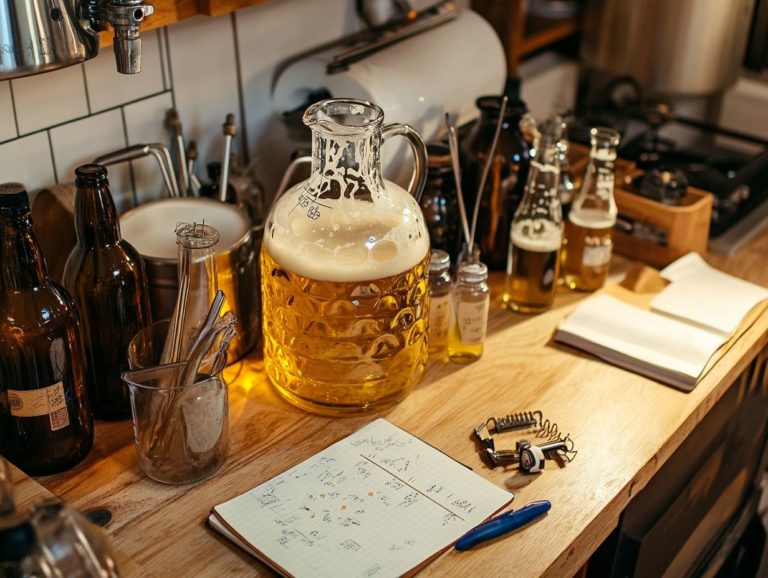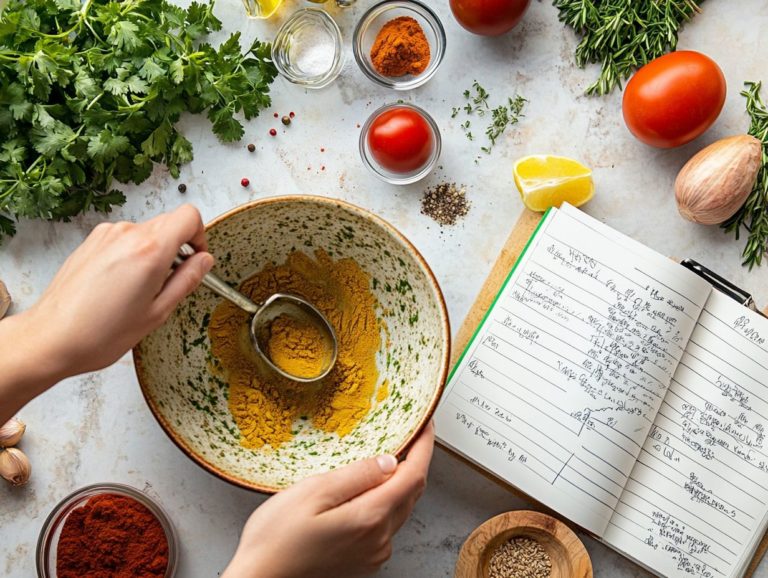How Do I Achieve the Perfect Foam?
Foam is not merely a playful texture; it serves a vital function in cooking, mixology, and even artistry. From topping off a caf latte to creating whipped cream, frothing milk is essential.
From the rich, creamy foam gracing your cappuccino to the delicate airiness of a culinary mousse, mastering the art of perfect foam can truly elevate your coffee beverages and culinary creations.
Get ready to dive into the world of foam! This guide will show you how to create perfect foam every time, highlighting various types of foam, what makes each one exceptional, and how you can master their creation whether you re using a steam wand, French press, or milk frother.
You ll uncover essential equipment, ingredients, and techniques, along with insights to sidestep common pitfalls.
Whether you’re looking to dazzle at your next dinner party with a macchiato or simply wish to experiment in the kitchen, understanding foam will unlock a realm of culinary possibilities.
Contents
Key Takeaways:

- The perfect foam is achieved by combining the right equipment, ingredients, and technique.
- Factors such as temperature, ingredients, and mixing speed can affect the quality of foam.
- To achieve the perfect foam, you will need equipment such as a milk steamer, thermometer, and ingredients like egg whites, gelatin, or non-dairy milk like macadamia milk.
What Is Foam?
Foam is that delightful, light, and airy texture that transforms your coffee experience, created by introducing air into a liquid. Think of frothy milk, with those tiny bubbles that elevate beverages like cappuccinos and lattes to a whole new level of indulgence.
You have several methods at your disposal to achieve this smooth foam, whether it s with a sleek milk frother, a steam wand, or even the classic whisk technique. Mastering the art of foam is essential for preparing exquisite espresso drinks and a variety of other coffee creations that will surely impress.
What Are the Different Types of Foam?
You can explore a variety of foam types, each shaped by the method used and the liquid being frothed. For instance, microfoam is your go-to for latte art, while foam derived from non-dairy milk caters to those seeking alternatives to traditional options.
Microfoam is created by steaming milk to produce tiny bubbles, resulting in a silky texture that elevates both the visual appeal and flavor of drinks like lattes and cappuccinos. Textured foam, which is less dense, often graces cappuccinos, providing a rich, creamy layer atop the coffee.
Non-dairy alternatives, such as oat or almond milk, have surged in popularity, as they can also be frothed into a light, airy foam, perfect for individuals with lactose intolerance or allergies. Each type of foam not only enhances the aesthetic of your beverage but also complements the unique flavors of various coffee and culinary experiences.
What Makes the Perfect Foam?
The perfect foam comes from a good mix of milk type, frothing technique, and the right heating temperature. Avoid scalding the milk to ensure the best results.
Mastering this delicate balance is crucial for crafting high-quality espresso drinks like cappuccinos, lattes, and even dirty chai lattes that showcase a rich, velvety foam.
What Factors Affect Foam Quality?
Several factors significantly influence the quality of your foam, including the type of milk you choose. Opt for milk that froths well 2% milk or whole milk typically performs best. The method you use for frothing, whether it’s a milk frother or a steam wand, also matters, along with the temperature of the milk. Overheating can lead to scalded milk and lackluster foam.
Your choice of milk is crucial, as different types have varying protein and fat contents that directly affect foam stability and texture. Whole milk, with its higher fat content, generally yields a creamier foam, while alternatives like almond or oat milk can produce distinct results thanks to their unique properties.
The frothing technique you employ is equally important; using a steam wand gives you better control over air incorporation and texture. Lastly, maintaining the right temperature is essential heating milk beyond 150 F can inhibit the proteins needed for lasting foam, ultimately impacting your beverage experience.
How Do I Achieve the Perfect Foam?
To achieve that impeccable foam for your favorite coffee creations, like lattes or cappuccinos, you must utilize the right equipment. Invest in a high-quality milk frother or steam wand, select the finest ingredients, and adhere to a careful method.
This careful approach not only elevates the foam but also enhances the overall experience of your espresso beverages. It allows you to savor every delightful sip.
What Equipment Do I Need?

Ready to make the perfect foam for your favorite coffee drinks? Equip yourself with specific tools like a milk frother, steam wand, or even a French press. If you lean toward manual methods, a whisk can also work wonders in achieving that delightful frothy result.
A milk frother is your trusty electric companion. It quickly whips air into the milk, creating a rich and creamy texture that’s just right for lattes and cappuccinos.
The steam wand, typically found on espresso machines, utilizes pressurized steam to heat and froth the milk. This produces the velvety microfoam that truly elevates your coffee experience.
If you’re feeling a bit more rustic, the French press allows you to froth milk by pumping the plunger up and down. This results in a light and airy foam that adds a unique touch to your drink.
Let’s not forget about the classic whisk. Although it may require a bit more effort and technique, it s perfect for those who relish a hands-on approach to coffee-making.
What Ingredients Do I Need?
To create the perfect foam for your coffee, start with high-quality milk. You have options like whole milk for that classic creaminess or non-dairy alternatives such as almond or Lactaid milk.
Don t forget about flavored syrups they can elevate your coffee experience to new heights. Each type of milk contributes a unique texture and flavor to the foam.
Whole milk, with its higher fat content, delivers a rich and creamy foam. Non-dairy options like almond milk create a lighter, airier texture, though they might not hold up as well under pressure.
If you’re steering clear of lactose, Lactaid milk offers a fantastic solution. It provides a creamy texture akin to whole milk without any discomfort.
Oat milk is also making waves in the coffee scene. It produces a velvety foam that s both thick and stable, making it a go-to choice for those who enjoy crafting latte art.
By incorporating flavored syrups, you can add a delightful twist to your beverages. This allows for a more personalized touch that suits your taste perfectly.
What Is the Process for Creating Foam?
Creating foam is an art that begins with the careful heating of milk, followed by the frothing techniques that integrate air. This results in a silky, creamy texture ideal for lattes, cappuccinos, and even masala chai.
-
Start by selecting fresh milk. Its fat content is vital for achieving that luxurious foam. Whole milk typically delivers the best results, but don t hesitate to explore alternatives like oat or almond milk if you prefer.
-
Pour the desired amount of milk into a frothing pitcher, making sure not to overfill it give it some space to expand. Heat the milk slowly, aiming for around 150 F (65 C), using either a microwave or stovetop. Ensure it s warm but not boiling.
-
Now, take your frother or steam wand and introduce air into the milk. Keep the tip just below the surface and move in a circular motion to create those small, velvety bubbles that are the hallmark of high-quality foam. Pay attention to the consistency and temperature throughout the process, and you ll achieve that perfect, silky finish every time.
What Are Some Tips for Achieving the Perfect Foam?
Achieving the perfect foam requires more than just the right equipment and ingredients. It demands a keen understanding of essential techniques.
You’ll want to master how to adjust foam density, ensure foam stability, and sidestep common mistakes that can compromise the quality of your coffee beverages.
By honing these skills, you can elevate your coffee experience to new heights. What are your favorite foam techniques? Share your thoughts below!
How Can I Adjust Foam Density?
Adjusting foam density is an art that you can master by fine-tuning your frothing technique, selecting the right type of milk, and choosing your heating method. This gives you the power to craft either a light, airy foam for delicate drinks or a denser foam that complements robust coffee beverages.
For example, if you desire a velvety texture in your cappuccino, opting for whole milk with its higher fat content will yield a luxuriously creamy foam. On the other hand, if you prefer non-dairy alternatives like almond or oat milk, you can still achieve a delightful froth. However, you may need to employ specific frothing techniques to accommodate their unique compositions.
Using a steam wand to heat your milk infuses it with microscopic air bubbles, resulting in a velvety microfoam. In contrast, a handheld frother can whip up foam more quickly, but it often produces a less stable texture.
Mastering these methods can elevate your coffee-making experience, enhancing both the presentation and flavor profiles of your creations. Incorporating barista tricks can further refine your skills, whether you’re crafting a latte or a cappuccino or experimenting with new flavors.
How Can I Make Foam More Stable?
To achieve a more stable foam, it’s crucial to select high-quality milk, consider incorporating stabilizers (additives that help keep the foam from collapsing), and learn how to froth milk correctly without over-whipping or scalding the milk.
Opting for milk with a higher fat content, such as whole or barista blends, can significantly elevate your foam quality, delivering a creamier texture and a more enjoyable mouthfeel. By adjusting your frothing technique like tilting the frothing pitcher you can promote a more uniform distribution of foam bubbles, resulting in a finer, denser foam.
If you’re keen to expand your options further, adding stabilizers such as soy lecithin or gelatin can help maintain the foam s structure over extended periods. This ensures that your delightful froth stays intact, whether you re crafting a masterpiece in a caf or perfecting your technique at home with a French press or the whisk method.
What Are Some Common Mistakes to Avoid?

When crafting that perfect foam, it’s easy to fall into some common traps, such as scalding the milk, using incorrect frothing techniques, or choosing the wrong type of milk. These missteps can lead to a disappointing texture that detracts from your coffee beverages. Get tips from experts like Paul Meikle-Janney to take your skills to the next level!
To achieve that luxurious, velvety finish that elevates your espresso or latte, it s crucial to monitor the temperature carefully. Aim for a range of 150 F to 155 F to avoid burning the milk. Mastering the art of using a steam wand can make a world of difference in the frothing process, ensuring that you incorporate air evenly to create that delightful microfoam that clings beautifully to your coffee.
Your choice of milk is equally important; opting for whole milk, Lactaid milk, or specialized barista blends typically yields far superior results compared to lower-fat options, which may not froth as richly. By honing these techniques and making informed decisions, you can truly elevate your coffee experience to new heights.
How Can I Use Foam in Different Applications?
Explore the exciting ways you can use foam to transform your coffee and desserts! Foam has its most notable presence in coffee drinks like lattes and cappuccinos, but it also plays a significant role in culinary creations, such as whipped cream or as a garnish for desserts, enhancing both flavor and presentation.
Don’t miss out on the chance to impress your friends with your barista skills!
What Foods Can I Use Foam In?
You can creatively incorporate foam into a variety of foods. For instance, whipped cream serves as a delightful topping for desserts, while airy sauces can elevate the flavor and texture of your dishes.
Chefs frequently utilize foams made from reduced stocks or juices. These provide a light and airy addition to proteins such as fish or poultry. Not only do they deliver a burst of flavor, but they also add a visually striking element to the plate. Have you ever imagined a saffron foam drizzled over a delicate scallop dish? This transforms your dining experience with intricate layers of taste and aroma. Culinary experts like Tracy Wilk often highlight this technique to enhance sophisticated dishes.
Fruit foams, created from purees, provide a refreshing contrast when paired with rich chocolate desserts or creamy panna cottas. You ll savor each bite while enjoying the playful texture that foams bring to the table.
How Can I Use Foam in Drinks?
Foam can be a delightful companion to your drinks, particularly in coffee creations where it forms a creamy layer. It also finds its place in cocktails and mocktails, adding a visually stunning and flavorful touch.
This airy texture enhances the drink’s visual appeal and enriches its overall flavor profile. Take lattes, for example: microfoam elevates the rich, roasted notes of espresso to new heights. In cocktails like a Whiskey Sour or a Ramos Gin Fizz, foam contributes a silky mouthfeel that beautifully complements the drink’s tartness or sweetness.
By exploring foams made from ingredients such as aquafaba, whipped cream, or flavored syrups, you can reinvent classic beverages into innovative experiences. As bartenders and baristas unleash their creativity with various foaming techniques, the possibilities for incorporating this delightful element into your drinks become virtually endless. Picture sipping on a vanilla chai latte topped with a frothy, spiced foam that complements the rich flavors within!
What Other Creative Uses Are There for Foam?
Foam boasts a multitude of creative applications in the culinary realm. It transforms ordinary dishes into visually striking masterpieces while introducing unique textures and flavors as delightful foamy garnishes for appetizers and entrees alike.
Chefs skillfully tap into the transformative power of foam through techniques such as emulsification (a method of mixing oil and water) and molecular gastronomy (the science of cooking that uses advanced techniques). This adds a contemporary flair to traditional recipes. Imagine the possibilities! With flavored foams, you can infuse surprising elements into your dishes, enhancing not just the taste but also the entire dining experience.
A vibrant citrus foam can elevate a luxurious seafood plate, while a fragrant herb foam harmonizes perfectly with grilled meats.
Foams can be customized for any occasion, from playful desserts that astonish guests with unexpected sweetness to elegant wine pairings. This offers a multisensory experience that showcases the artistry and innovation inherent in modern cuisine.
Frequently Asked Questions
How Do I Achieve the Perfect Foam?

To achieve the perfect foam, start with fresh, cold milk and a clean frothing pitcher.
What type of milk should I use to achieve the perfect foam?
For the best results, use whole milk. It has a higher fat content and will create a richer and creamier foam. Using a well-designed milk jug also helps achieve the desired consistency.
Why is it important to start with cold milk?
Cold milk creates a denser foam, resulting in a more velvety texture. Room temperature milk will not produce the same results.
Do I need a specific type of frothing pitcher?
While a frothing pitcher is recommended for achieving the perfect foam, you can also use a wide-mouthed jar or a French press. Just ensure it can withstand heat and has enough room for the milk to expand. Specialty stores like Whole Latte Love offer a range of tools to suit your frothing needs!
How much milk should I use for the perfect foam?
As a general rule, use about half the volume of your cup for the milk. This will allow enough room for the foam to expand without overflowing.
Frothing Milk Without a Milk Frother
Can I achieve the perfect foam without a milk frother?
Absolutely! You can create delicious foam right at home without a frother. Just heat your milk in a saucepan and whisk it vigorously until it s light and frothy.






